Media's Role in Society: An Essay on Information and Influence
VerifiedAdded on 2020/04/21
|11
|3312
|209
Essay
AI Summary
This essay explores the multifaceted role of media in the modern era, examining its evolution from traditional forms like newspapers and television to the digital landscape of the internet and social media. It delves into the essential functions of media, including informing, entertaining, and educating the public, while also acknowledging its influence on shaping public opinion and serving as a cornerstone of democracy. The essay highlights the concept of the 'information society' and the impact of technology on communication, referencing Marshall McLuhan's 'global village' concept. It critically analyzes the potential negative aspects of media, such as the spread of propaganda, the manipulation of information, and the influence of advertising. Furthermore, it discusses the propaganda model, which explains how power and wealth shape the news, and the role of media in dividing people. Overall, the essay provides a comprehensive overview of media's significance, challenges, and its impact on society.
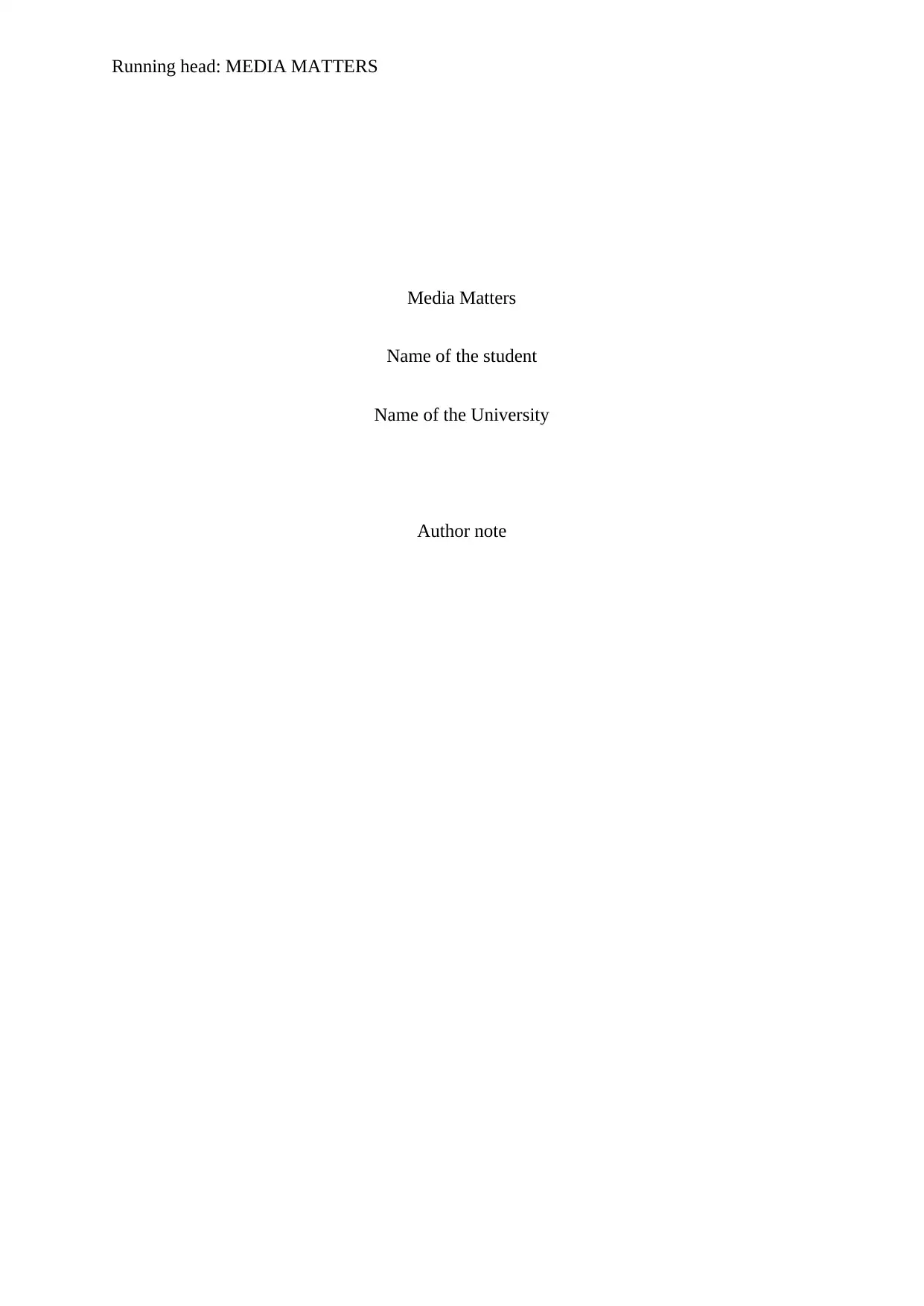
Running head: MEDIA MATTERS
Media Matters
Name of the student
Name of the University
Author note
Media Matters
Name of the student
Name of the University
Author note
Paraphrase This Document
Need a fresh take? Get an instant paraphrase of this document with our AI Paraphraser

1MEDIA IN THE MODERN ERA
Essay 3: Media Matters
Media is a collective communication tool that is used in order to store and deliver
data. It is an important channel of communication in the society like that of newspaper,
television and radio. It goes back to the days of the ancient era when cave paintings were
used in order to solve the purpose of communication. The word “communication” has been
derived from that of the Latin root communicare. The importance of media is in the fact that
it addresses a large target audience. Initially, it was used in reference to books along with
newspapers however with the advent of technology it now encompasses the use of internet,
movies and television (Van Dalen, de Vreese and Albæk 2017). Media is essential in
fulfilling the daily needs of man and it proves to be an important factor in shaping the public
opinion. It is the main arm of democracy. It protects the interest of the public against
corruption and malpractice. Media matters in the modern world as it performs the three
important functions- inform, entertain and educate. Life without media is indispensable in the
modern world and media matters as it helps people to know about important events going on
in the world and at the same time provides entertainment to people. Mass Media plays the
important role of educating people about important social issues.
Information is an important feature in the modern world. Information Society is a
term that is used for a society in which the manipulation of information has emerged to
become the most important cultural activity. The information society can be contrasted with
with the societies where the economic underpinning was mainly industrial. Machine tools in
relation to Information Society are that of computers and telecommunications instead of
ploughs. Marshall Mac Luhan has very aptly predicted that communication media would
change the world into that of a “global village”. In Theories of The Information Society,
Frank Webster talks about information explosion and examines the post-war theories in
Essay 3: Media Matters
Media is a collective communication tool that is used in order to store and deliver
data. It is an important channel of communication in the society like that of newspaper,
television and radio. It goes back to the days of the ancient era when cave paintings were
used in order to solve the purpose of communication. The word “communication” has been
derived from that of the Latin root communicare. The importance of media is in the fact that
it addresses a large target audience. Initially, it was used in reference to books along with
newspapers however with the advent of technology it now encompasses the use of internet,
movies and television (Van Dalen, de Vreese and Albæk 2017). Media is essential in
fulfilling the daily needs of man and it proves to be an important factor in shaping the public
opinion. It is the main arm of democracy. It protects the interest of the public against
corruption and malpractice. Media matters in the modern world as it performs the three
important functions- inform, entertain and educate. Life without media is indispensable in the
modern world and media matters as it helps people to know about important events going on
in the world and at the same time provides entertainment to people. Mass Media plays the
important role of educating people about important social issues.
Information is an important feature in the modern world. Information Society is a
term that is used for a society in which the manipulation of information has emerged to
become the most important cultural activity. The information society can be contrasted with
with the societies where the economic underpinning was mainly industrial. Machine tools in
relation to Information Society are that of computers and telecommunications instead of
ploughs. Marshall Mac Luhan has very aptly predicted that communication media would
change the world into that of a “global village”. In Theories of The Information Society,
Frank Webster talks about information explosion and examines the post-war theories in
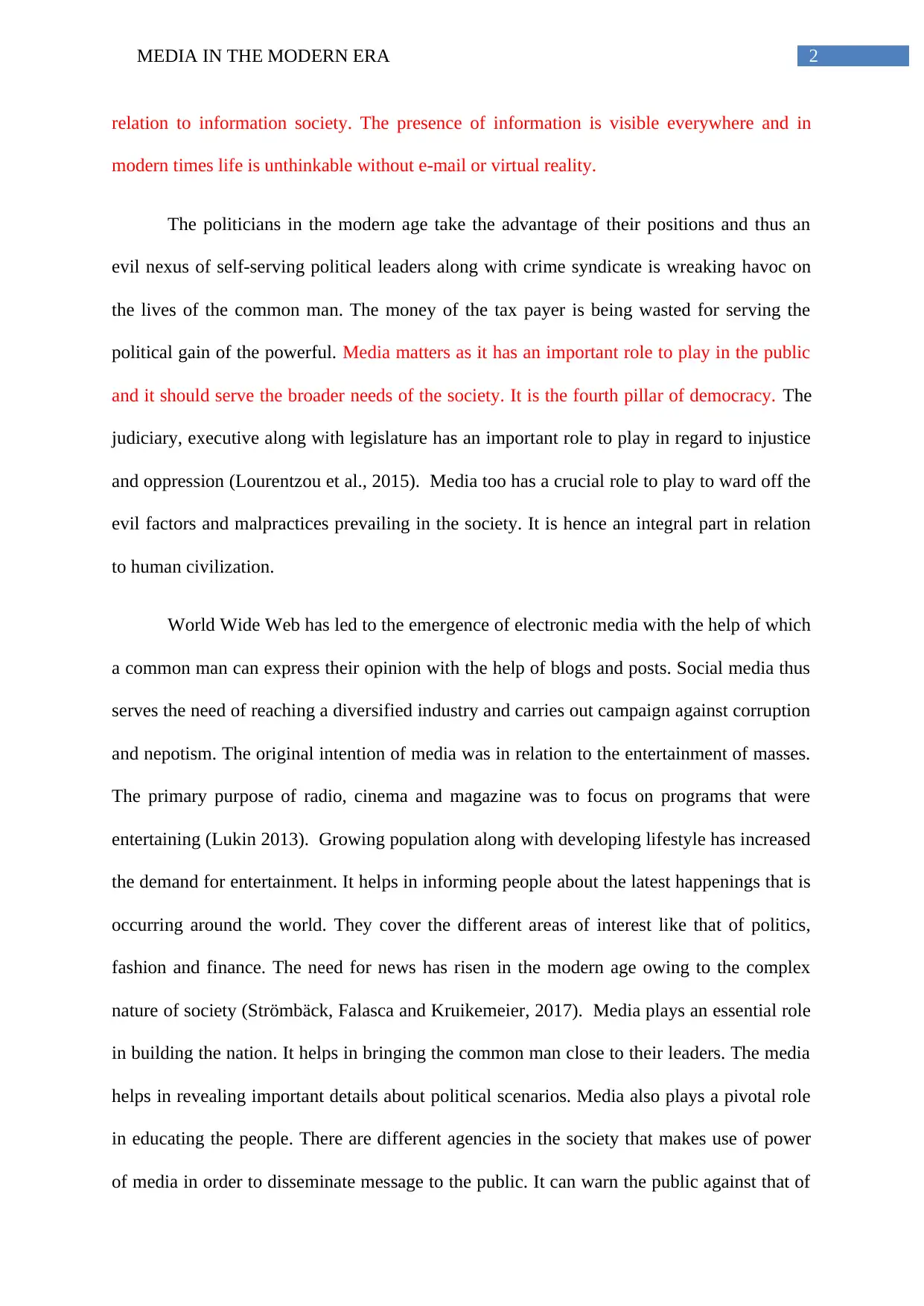
2MEDIA IN THE MODERN ERA
relation to information society. The presence of information is visible everywhere and in
modern times life is unthinkable without e-mail or virtual reality.
The politicians in the modern age take the advantage of their positions and thus an
evil nexus of self-serving political leaders along with crime syndicate is wreaking havoc on
the lives of the common man. The money of the tax payer is being wasted for serving the
political gain of the powerful. Media matters as it has an important role to play in the public
and it should serve the broader needs of the society. It is the fourth pillar of democracy. The
judiciary, executive along with legislature has an important role to play in regard to injustice
and oppression (Lourentzou et al., 2015). Media too has a crucial role to play to ward off the
evil factors and malpractices prevailing in the society. It is hence an integral part in relation
to human civilization.
World Wide Web has led to the emergence of electronic media with the help of which
a common man can express their opinion with the help of blogs and posts. Social media thus
serves the need of reaching a diversified industry and carries out campaign against corruption
and nepotism. The original intention of media was in relation to the entertainment of masses.
The primary purpose of radio, cinema and magazine was to focus on programs that were
entertaining (Lukin 2013). Growing population along with developing lifestyle has increased
the demand for entertainment. It helps in informing people about the latest happenings that is
occurring around the world. They cover the different areas of interest like that of politics,
fashion and finance. The need for news has risen in the modern age owing to the complex
nature of society (Strömbäck, Falasca and Kruikemeier, 2017). Media plays an essential role
in building the nation. It helps in bringing the common man close to their leaders. The media
helps in revealing important details about political scenarios. Media also plays a pivotal role
in educating the people. There are different agencies in the society that makes use of power
of media in order to disseminate message to the public. It can warn the public against that of
relation to information society. The presence of information is visible everywhere and in
modern times life is unthinkable without e-mail or virtual reality.
The politicians in the modern age take the advantage of their positions and thus an
evil nexus of self-serving political leaders along with crime syndicate is wreaking havoc on
the lives of the common man. The money of the tax payer is being wasted for serving the
political gain of the powerful. Media matters as it has an important role to play in the public
and it should serve the broader needs of the society. It is the fourth pillar of democracy. The
judiciary, executive along with legislature has an important role to play in regard to injustice
and oppression (Lourentzou et al., 2015). Media too has a crucial role to play to ward off the
evil factors and malpractices prevailing in the society. It is hence an integral part in relation
to human civilization.
World Wide Web has led to the emergence of electronic media with the help of which
a common man can express their opinion with the help of blogs and posts. Social media thus
serves the need of reaching a diversified industry and carries out campaign against corruption
and nepotism. The original intention of media was in relation to the entertainment of masses.
The primary purpose of radio, cinema and magazine was to focus on programs that were
entertaining (Lukin 2013). Growing population along with developing lifestyle has increased
the demand for entertainment. It helps in informing people about the latest happenings that is
occurring around the world. They cover the different areas of interest like that of politics,
fashion and finance. The need for news has risen in the modern age owing to the complex
nature of society (Strömbäck, Falasca and Kruikemeier, 2017). Media plays an essential role
in building the nation. It helps in bringing the common man close to their leaders. The media
helps in revealing important details about political scenarios. Media also plays a pivotal role
in educating the people. There are different agencies in the society that makes use of power
of media in order to disseminate message to the public. It can warn the public against that of
⊘ This is a preview!⊘
Do you want full access?
Subscribe today to unlock all pages.

Trusted by 1+ million students worldwide
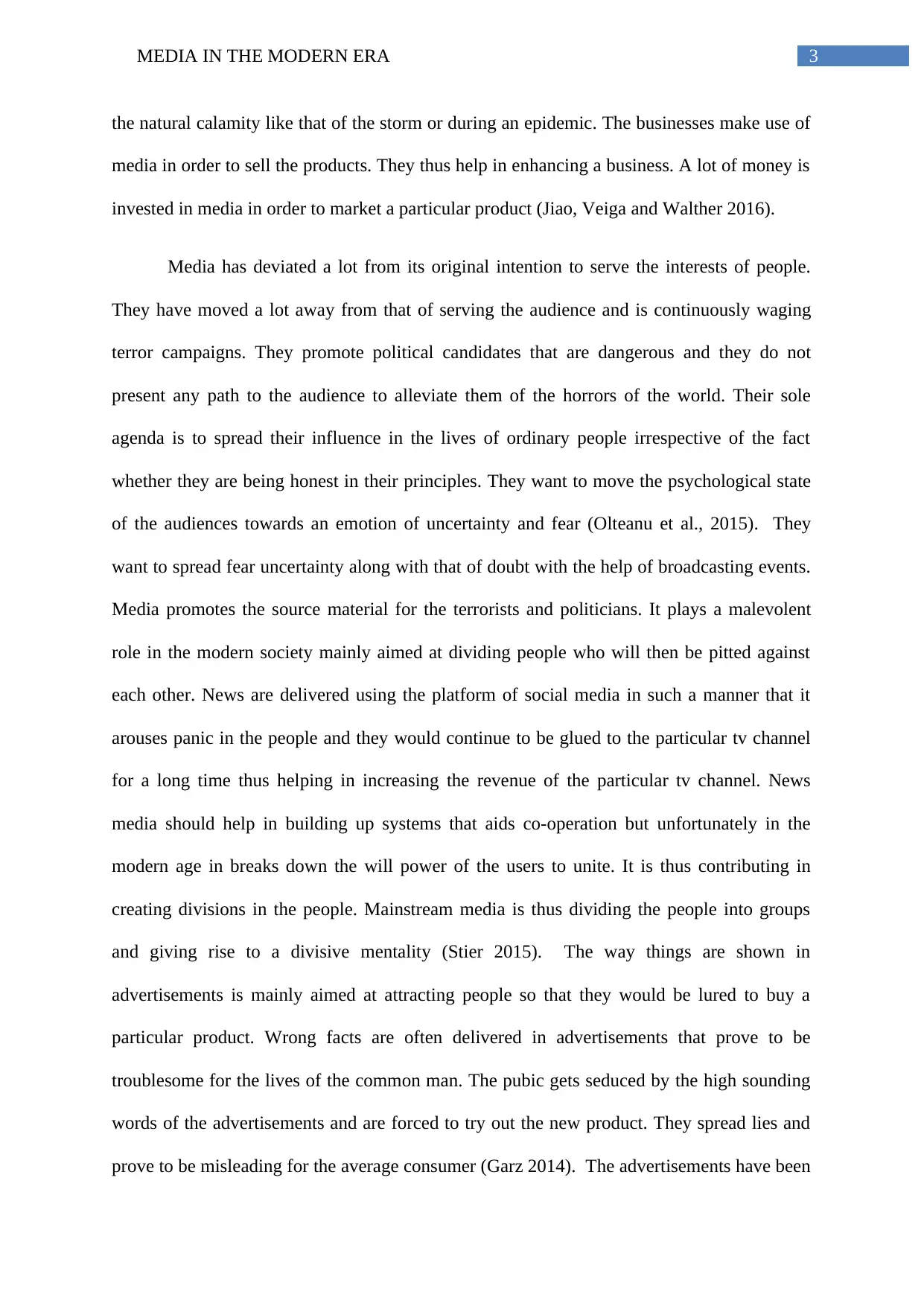
3MEDIA IN THE MODERN ERA
the natural calamity like that of the storm or during an epidemic. The businesses make use of
media in order to sell the products. They thus help in enhancing a business. A lot of money is
invested in media in order to market a particular product (Jiao, Veiga and Walther 2016).
Media has deviated a lot from its original intention to serve the interests of people.
They have moved a lot away from that of serving the audience and is continuously waging
terror campaigns. They promote political candidates that are dangerous and they do not
present any path to the audience to alleviate them of the horrors of the world. Their sole
agenda is to spread their influence in the lives of ordinary people irrespective of the fact
whether they are being honest in their principles. They want to move the psychological state
of the audiences towards an emotion of uncertainty and fear (Olteanu et al., 2015). They
want to spread fear uncertainty along with that of doubt with the help of broadcasting events.
Media promotes the source material for the terrorists and politicians. It plays a malevolent
role in the modern society mainly aimed at dividing people who will then be pitted against
each other. News are delivered using the platform of social media in such a manner that it
arouses panic in the people and they would continue to be glued to the particular tv channel
for a long time thus helping in increasing the revenue of the particular tv channel. News
media should help in building up systems that aids co-operation but unfortunately in the
modern age in breaks down the will power of the users to unite. It is thus contributing in
creating divisions in the people. Mainstream media is thus dividing the people into groups
and giving rise to a divisive mentality (Stier 2015). The way things are shown in
advertisements is mainly aimed at attracting people so that they would be lured to buy a
particular product. Wrong facts are often delivered in advertisements that prove to be
troublesome for the lives of the common man. The pubic gets seduced by the high sounding
words of the advertisements and are forced to try out the new product. They spread lies and
prove to be misleading for the average consumer (Garz 2014). The advertisements have been
the natural calamity like that of the storm or during an epidemic. The businesses make use of
media in order to sell the products. They thus help in enhancing a business. A lot of money is
invested in media in order to market a particular product (Jiao, Veiga and Walther 2016).
Media has deviated a lot from its original intention to serve the interests of people.
They have moved a lot away from that of serving the audience and is continuously waging
terror campaigns. They promote political candidates that are dangerous and they do not
present any path to the audience to alleviate them of the horrors of the world. Their sole
agenda is to spread their influence in the lives of ordinary people irrespective of the fact
whether they are being honest in their principles. They want to move the psychological state
of the audiences towards an emotion of uncertainty and fear (Olteanu et al., 2015). They
want to spread fear uncertainty along with that of doubt with the help of broadcasting events.
Media promotes the source material for the terrorists and politicians. It plays a malevolent
role in the modern society mainly aimed at dividing people who will then be pitted against
each other. News are delivered using the platform of social media in such a manner that it
arouses panic in the people and they would continue to be glued to the particular tv channel
for a long time thus helping in increasing the revenue of the particular tv channel. News
media should help in building up systems that aids co-operation but unfortunately in the
modern age in breaks down the will power of the users to unite. It is thus contributing in
creating divisions in the people. Mainstream media is thus dividing the people into groups
and giving rise to a divisive mentality (Stier 2015). The way things are shown in
advertisements is mainly aimed at attracting people so that they would be lured to buy a
particular product. Wrong facts are often delivered in advertisements that prove to be
troublesome for the lives of the common man. The pubic gets seduced by the high sounding
words of the advertisements and are forced to try out the new product. They spread lies and
prove to be misleading for the average consumer (Garz 2014). The advertisements have been
Paraphrase This Document
Need a fresh take? Get an instant paraphrase of this document with our AI Paraphraser
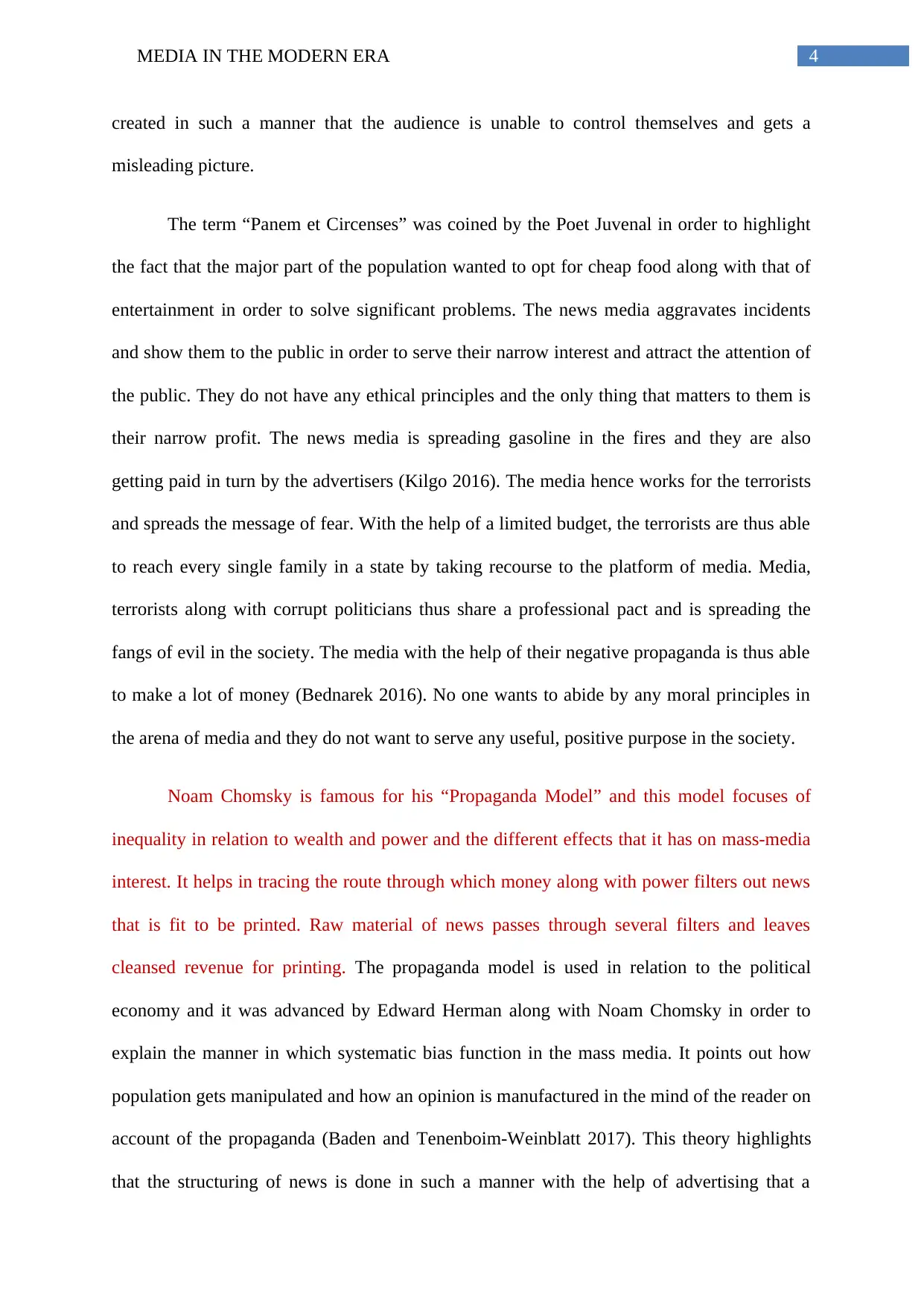
4MEDIA IN THE MODERN ERA
created in such a manner that the audience is unable to control themselves and gets a
misleading picture.
The term “Panem et Circenses” was coined by the Poet Juvenal in order to highlight
the fact that the major part of the population wanted to opt for cheap food along with that of
entertainment in order to solve significant problems. The news media aggravates incidents
and show them to the public in order to serve their narrow interest and attract the attention of
the public. They do not have any ethical principles and the only thing that matters to them is
their narrow profit. The news media is spreading gasoline in the fires and they are also
getting paid in turn by the advertisers (Kilgo 2016). The media hence works for the terrorists
and spreads the message of fear. With the help of a limited budget, the terrorists are thus able
to reach every single family in a state by taking recourse to the platform of media. Media,
terrorists along with corrupt politicians thus share a professional pact and is spreading the
fangs of evil in the society. The media with the help of their negative propaganda is thus able
to make a lot of money (Bednarek 2016). No one wants to abide by any moral principles in
the arena of media and they do not want to serve any useful, positive purpose in the society.
Noam Chomsky is famous for his “Propaganda Model” and this model focuses of
inequality in relation to wealth and power and the different effects that it has on mass-media
interest. It helps in tracing the route through which money along with power filters out news
that is fit to be printed. Raw material of news passes through several filters and leaves
cleansed revenue for printing. The propaganda model is used in relation to the political
economy and it was advanced by Edward Herman along with Noam Chomsky in order to
explain the manner in which systematic bias function in the mass media. It points out how
population gets manipulated and how an opinion is manufactured in the mind of the reader on
account of the propaganda (Baden and Tenenboim-Weinblatt 2017). This theory highlights
that the structuring of news is done in such a manner with the help of advertising that a
created in such a manner that the audience is unable to control themselves and gets a
misleading picture.
The term “Panem et Circenses” was coined by the Poet Juvenal in order to highlight
the fact that the major part of the population wanted to opt for cheap food along with that of
entertainment in order to solve significant problems. The news media aggravates incidents
and show them to the public in order to serve their narrow interest and attract the attention of
the public. They do not have any ethical principles and the only thing that matters to them is
their narrow profit. The news media is spreading gasoline in the fires and they are also
getting paid in turn by the advertisers (Kilgo 2016). The media hence works for the terrorists
and spreads the message of fear. With the help of a limited budget, the terrorists are thus able
to reach every single family in a state by taking recourse to the platform of media. Media,
terrorists along with corrupt politicians thus share a professional pact and is spreading the
fangs of evil in the society. The media with the help of their negative propaganda is thus able
to make a lot of money (Bednarek 2016). No one wants to abide by any moral principles in
the arena of media and they do not want to serve any useful, positive purpose in the society.
Noam Chomsky is famous for his “Propaganda Model” and this model focuses of
inequality in relation to wealth and power and the different effects that it has on mass-media
interest. It helps in tracing the route through which money along with power filters out news
that is fit to be printed. Raw material of news passes through several filters and leaves
cleansed revenue for printing. The propaganda model is used in relation to the political
economy and it was advanced by Edward Herman along with Noam Chomsky in order to
explain the manner in which systematic bias function in the mass media. It points out how
population gets manipulated and how an opinion is manufactured in the mind of the reader on
account of the propaganda (Baden and Tenenboim-Weinblatt 2017). This theory highlights
that the structuring of news is done in such a manner with the help of advertising that a
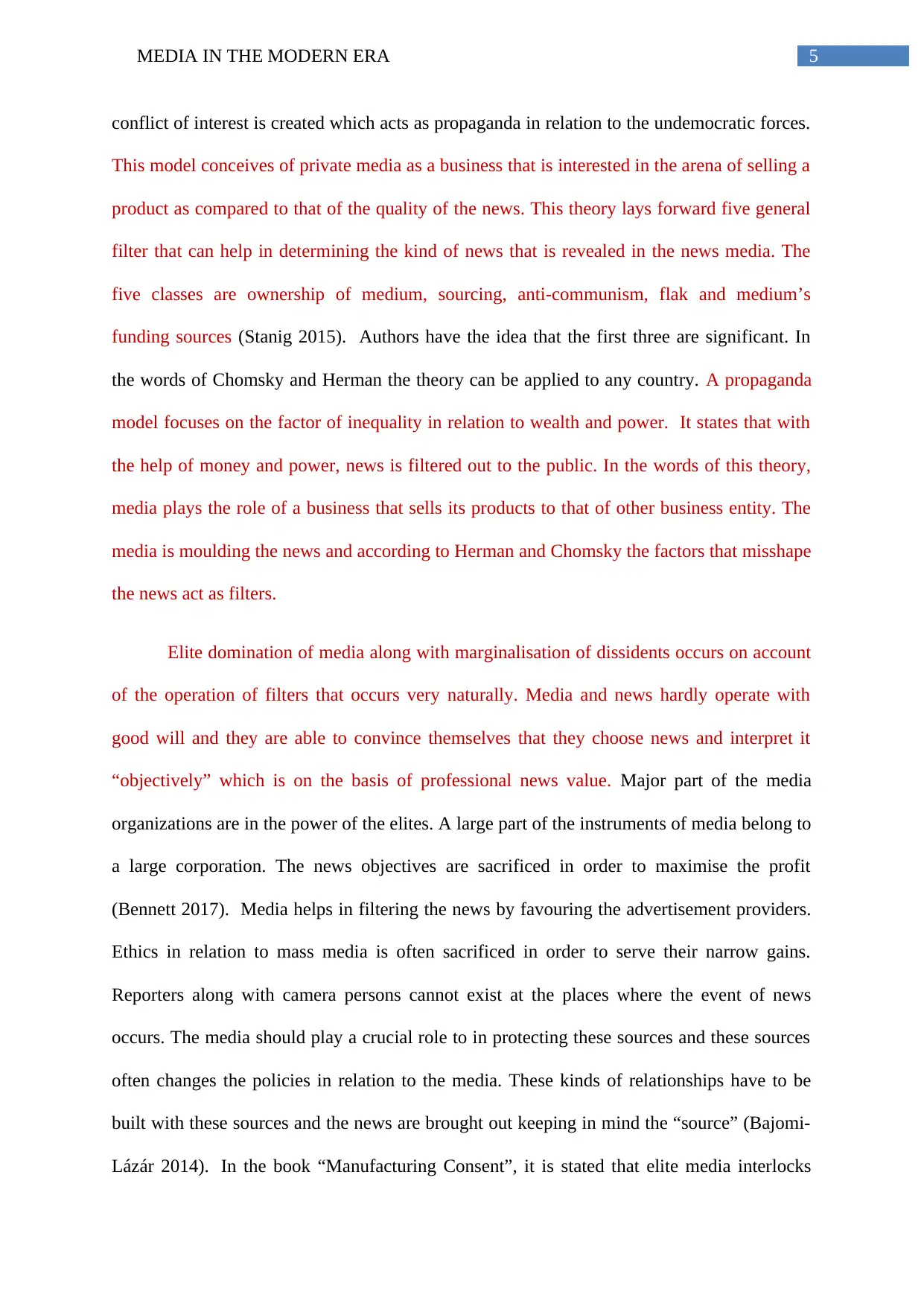
5MEDIA IN THE MODERN ERA
conflict of interest is created which acts as propaganda in relation to the undemocratic forces.
This model conceives of private media as a business that is interested in the arena of selling a
product as compared to that of the quality of the news. This theory lays forward five general
filter that can help in determining the kind of news that is revealed in the news media. The
five classes are ownership of medium, sourcing, anti-communism, flak and medium’s
funding sources (Stanig 2015). Authors have the idea that the first three are significant. In
the words of Chomsky and Herman the theory can be applied to any country. A propaganda
model focuses on the factor of inequality in relation to wealth and power. It states that with
the help of money and power, news is filtered out to the public. In the words of this theory,
media plays the role of a business that sells its products to that of other business entity. The
media is moulding the news and according to Herman and Chomsky the factors that misshape
the news act as filters.
Elite domination of media along with marginalisation of dissidents occurs on account
of the operation of filters that occurs very naturally. Media and news hardly operate with
good will and they are able to convince themselves that they choose news and interpret it
“objectively” which is on the basis of professional news value. Major part of the media
organizations are in the power of the elites. A large part of the instruments of media belong to
a large corporation. The news objectives are sacrificed in order to maximise the profit
(Bennett 2017). Media helps in filtering the news by favouring the advertisement providers.
Ethics in relation to mass media is often sacrificed in order to serve their narrow gains.
Reporters along with camera persons cannot exist at the places where the event of news
occurs. The media should play a crucial role to in protecting these sources and these sources
often changes the policies in relation to the media. These kinds of relationships have to be
built with these sources and the news are brought out keeping in mind the “source” (Bajomi-
Lázár 2014). In the book “Manufacturing Consent”, it is stated that elite media interlocks
conflict of interest is created which acts as propaganda in relation to the undemocratic forces.
This model conceives of private media as a business that is interested in the arena of selling a
product as compared to that of the quality of the news. This theory lays forward five general
filter that can help in determining the kind of news that is revealed in the news media. The
five classes are ownership of medium, sourcing, anti-communism, flak and medium’s
funding sources (Stanig 2015). Authors have the idea that the first three are significant. In
the words of Chomsky and Herman the theory can be applied to any country. A propaganda
model focuses on the factor of inequality in relation to wealth and power. It states that with
the help of money and power, news is filtered out to the public. In the words of this theory,
media plays the role of a business that sells its products to that of other business entity. The
media is moulding the news and according to Herman and Chomsky the factors that misshape
the news act as filters.
Elite domination of media along with marginalisation of dissidents occurs on account
of the operation of filters that occurs very naturally. Media and news hardly operate with
good will and they are able to convince themselves that they choose news and interpret it
“objectively” which is on the basis of professional news value. Major part of the media
organizations are in the power of the elites. A large part of the instruments of media belong to
a large corporation. The news objectives are sacrificed in order to maximise the profit
(Bennett 2017). Media helps in filtering the news by favouring the advertisement providers.
Ethics in relation to mass media is often sacrificed in order to serve their narrow gains.
Reporters along with camera persons cannot exist at the places where the event of news
occurs. The media should play a crucial role to in protecting these sources and these sources
often changes the policies in relation to the media. These kinds of relationships have to be
built with these sources and the news are brought out keeping in mind the “source” (Bajomi-
Lázár 2014). In the book “Manufacturing Consent”, it is stated that elite media interlocks
⊘ This is a preview!⊘
Do you want full access?
Subscribe today to unlock all pages.

Trusted by 1+ million students worldwide
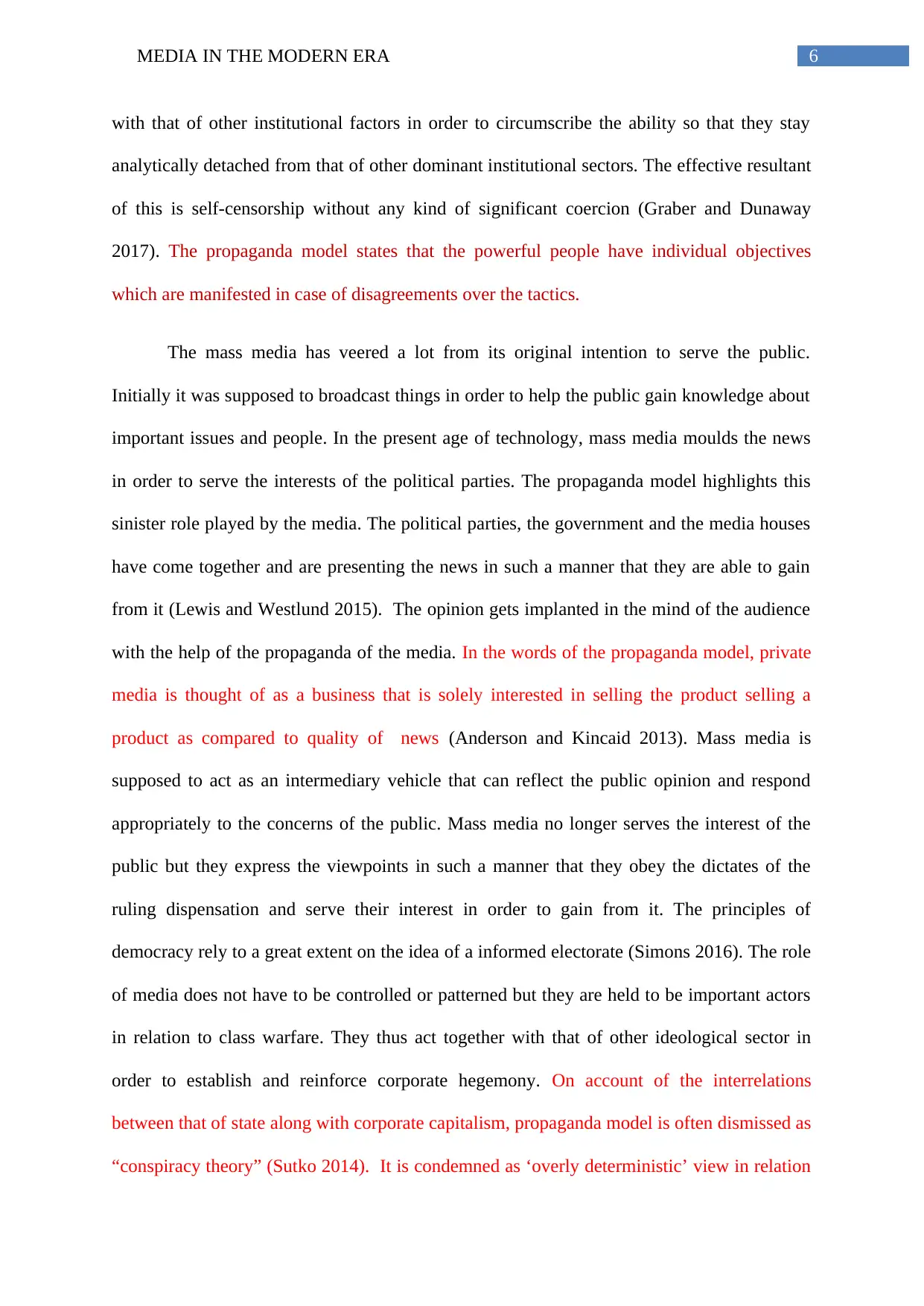
6MEDIA IN THE MODERN ERA
with that of other institutional factors in order to circumscribe the ability so that they stay
analytically detached from that of other dominant institutional sectors. The effective resultant
of this is self-censorship without any kind of significant coercion (Graber and Dunaway
2017). The propaganda model states that the powerful people have individual objectives
which are manifested in case of disagreements over the tactics.
The mass media has veered a lot from its original intention to serve the public.
Initially it was supposed to broadcast things in order to help the public gain knowledge about
important issues and people. In the present age of technology, mass media moulds the news
in order to serve the interests of the political parties. The propaganda model highlights this
sinister role played by the media. The political parties, the government and the media houses
have come together and are presenting the news in such a manner that they are able to gain
from it (Lewis and Westlund 2015). The opinion gets implanted in the mind of the audience
with the help of the propaganda of the media. In the words of the propaganda model, private
media is thought of as a business that is solely interested in selling the product selling a
product as compared to quality of news (Anderson and Kincaid 2013). Mass media is
supposed to act as an intermediary vehicle that can reflect the public opinion and respond
appropriately to the concerns of the public. Mass media no longer serves the interest of the
public but they express the viewpoints in such a manner that they obey the dictates of the
ruling dispensation and serve their interest in order to gain from it. The principles of
democracy rely to a great extent on the idea of a informed electorate (Simons 2016). The role
of media does not have to be controlled or patterned but they are held to be important actors
in relation to class warfare. They thus act together with that of other ideological sector in
order to establish and reinforce corporate hegemony. On account of the interrelations
between that of state along with corporate capitalism, propaganda model is often dismissed as
“conspiracy theory” (Sutko 2014). It is condemned as ‘overly deterministic’ view in relation
with that of other institutional factors in order to circumscribe the ability so that they stay
analytically detached from that of other dominant institutional sectors. The effective resultant
of this is self-censorship without any kind of significant coercion (Graber and Dunaway
2017). The propaganda model states that the powerful people have individual objectives
which are manifested in case of disagreements over the tactics.
The mass media has veered a lot from its original intention to serve the public.
Initially it was supposed to broadcast things in order to help the public gain knowledge about
important issues and people. In the present age of technology, mass media moulds the news
in order to serve the interests of the political parties. The propaganda model highlights this
sinister role played by the media. The political parties, the government and the media houses
have come together and are presenting the news in such a manner that they are able to gain
from it (Lewis and Westlund 2015). The opinion gets implanted in the mind of the audience
with the help of the propaganda of the media. In the words of the propaganda model, private
media is thought of as a business that is solely interested in selling the product selling a
product as compared to quality of news (Anderson and Kincaid 2013). Mass media is
supposed to act as an intermediary vehicle that can reflect the public opinion and respond
appropriately to the concerns of the public. Mass media no longer serves the interest of the
public but they express the viewpoints in such a manner that they obey the dictates of the
ruling dispensation and serve their interest in order to gain from it. The principles of
democracy rely to a great extent on the idea of a informed electorate (Simons 2016). The role
of media does not have to be controlled or patterned but they are held to be important actors
in relation to class warfare. They thus act together with that of other ideological sector in
order to establish and reinforce corporate hegemony. On account of the interrelations
between that of state along with corporate capitalism, propaganda model is often dismissed as
“conspiracy theory” (Sutko 2014). It is condemned as ‘overly deterministic’ view in relation
Paraphrase This Document
Need a fresh take? Get an instant paraphrase of this document with our AI Paraphraser
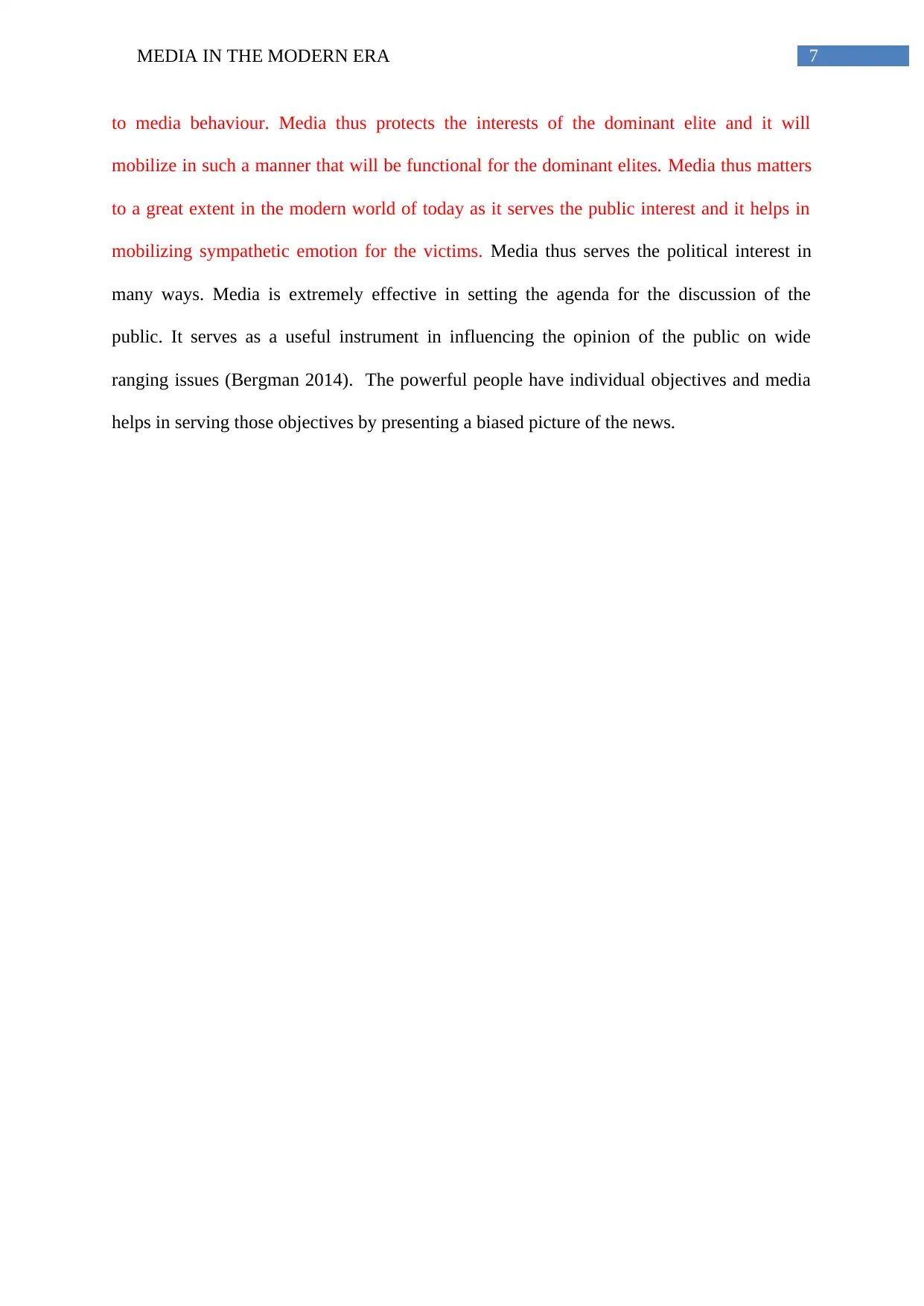
7MEDIA IN THE MODERN ERA
to media behaviour. Media thus protects the interests of the dominant elite and it will
mobilize in such a manner that will be functional for the dominant elites. Media thus matters
to a great extent in the modern world of today as it serves the public interest and it helps in
mobilizing sympathetic emotion for the victims. Media thus serves the political interest in
many ways. Media is extremely effective in setting the agenda for the discussion of the
public. It serves as a useful instrument in influencing the opinion of the public on wide
ranging issues (Bergman 2014). The powerful people have individual objectives and media
helps in serving those objectives by presenting a biased picture of the news.
to media behaviour. Media thus protects the interests of the dominant elite and it will
mobilize in such a manner that will be functional for the dominant elites. Media thus matters
to a great extent in the modern world of today as it serves the public interest and it helps in
mobilizing sympathetic emotion for the victims. Media thus serves the political interest in
many ways. Media is extremely effective in setting the agenda for the discussion of the
public. It serves as a useful instrument in influencing the opinion of the public on wide
ranging issues (Bergman 2014). The powerful people have individual objectives and media
helps in serving those objectives by presenting a biased picture of the news.
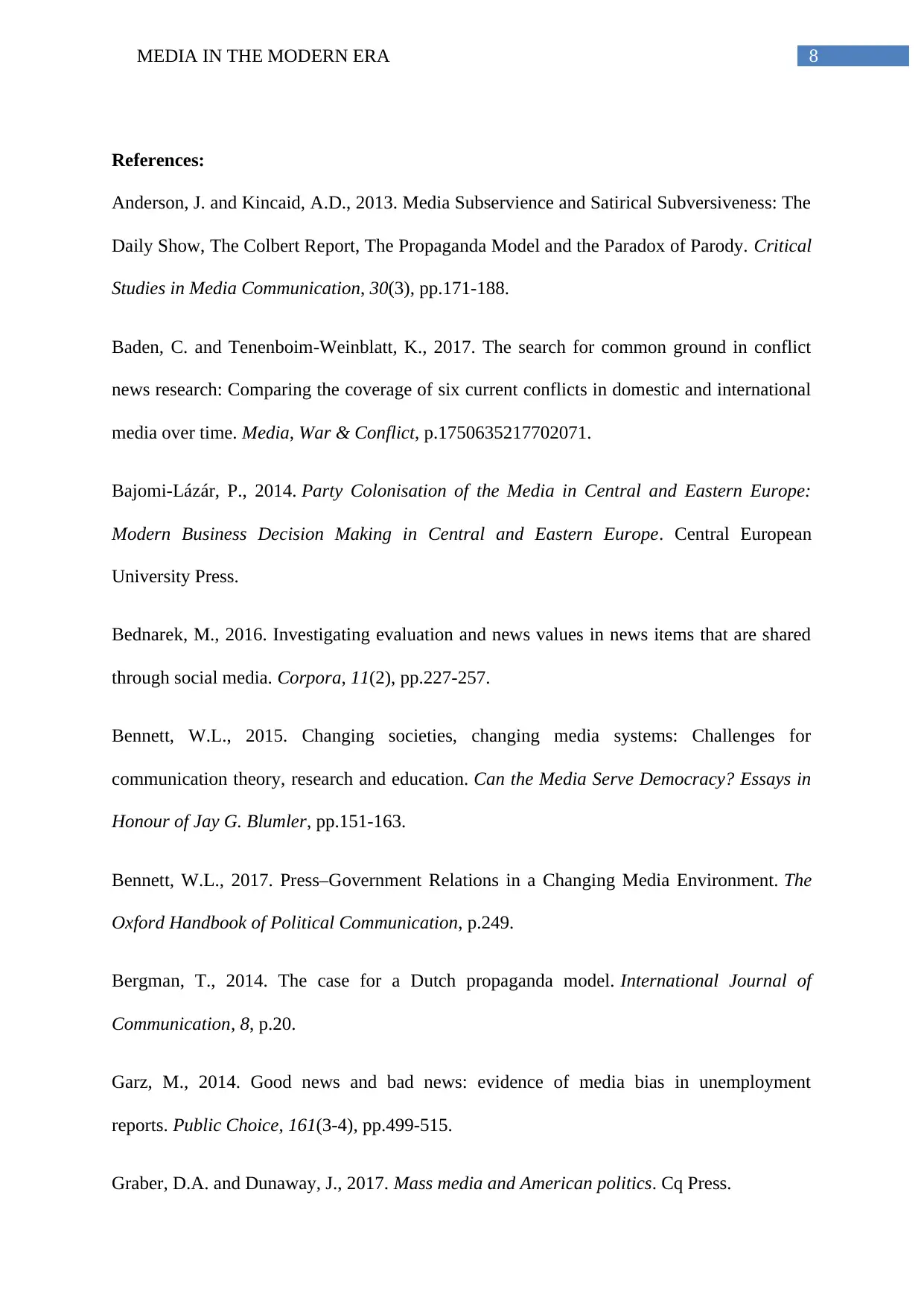
8MEDIA IN THE MODERN ERA
References:
Anderson, J. and Kincaid, A.D., 2013. Media Subservience and Satirical Subversiveness: The
Daily Show, The Colbert Report, The Propaganda Model and the Paradox of Parody. Critical
Studies in Media Communication, 30(3), pp.171-188.
Baden, C. and Tenenboim-Weinblatt, K., 2017. The search for common ground in conflict
news research: Comparing the coverage of six current conflicts in domestic and international
media over time. Media, War & Conflict, p.1750635217702071.
Bajomi-Lázár, P., 2014. Party Colonisation of the Media in Central and Eastern Europe:
Modern Business Decision Making in Central and Eastern Europe. Central European
University Press.
Bednarek, M., 2016. Investigating evaluation and news values in news items that are shared
through social media. Corpora, 11(2), pp.227-257.
Bennett, W.L., 2015. Changing societies, changing media systems: Challenges for
communication theory, research and education. Can the Media Serve Democracy? Essays in
Honour of Jay G. Blumler, pp.151-163.
Bennett, W.L., 2017. Press–Government Relations in a Changing Media Environment. The
Oxford Handbook of Political Communication, p.249.
Bergman, T., 2014. The case for a Dutch propaganda model. International Journal of
Communication, 8, p.20.
Garz, M., 2014. Good news and bad news: evidence of media bias in unemployment
reports. Public Choice, 161(3-4), pp.499-515.
Graber, D.A. and Dunaway, J., 2017. Mass media and American politics. Cq Press.
References:
Anderson, J. and Kincaid, A.D., 2013. Media Subservience and Satirical Subversiveness: The
Daily Show, The Colbert Report, The Propaganda Model and the Paradox of Parody. Critical
Studies in Media Communication, 30(3), pp.171-188.
Baden, C. and Tenenboim-Weinblatt, K., 2017. The search for common ground in conflict
news research: Comparing the coverage of six current conflicts in domestic and international
media over time. Media, War & Conflict, p.1750635217702071.
Bajomi-Lázár, P., 2014. Party Colonisation of the Media in Central and Eastern Europe:
Modern Business Decision Making in Central and Eastern Europe. Central European
University Press.
Bednarek, M., 2016. Investigating evaluation and news values in news items that are shared
through social media. Corpora, 11(2), pp.227-257.
Bennett, W.L., 2015. Changing societies, changing media systems: Challenges for
communication theory, research and education. Can the Media Serve Democracy? Essays in
Honour of Jay G. Blumler, pp.151-163.
Bennett, W.L., 2017. Press–Government Relations in a Changing Media Environment. The
Oxford Handbook of Political Communication, p.249.
Bergman, T., 2014. The case for a Dutch propaganda model. International Journal of
Communication, 8, p.20.
Garz, M., 2014. Good news and bad news: evidence of media bias in unemployment
reports. Public Choice, 161(3-4), pp.499-515.
Graber, D.A. and Dunaway, J., 2017. Mass media and American politics. Cq Press.
⊘ This is a preview!⊘
Do you want full access?
Subscribe today to unlock all pages.

Trusted by 1+ million students worldwide
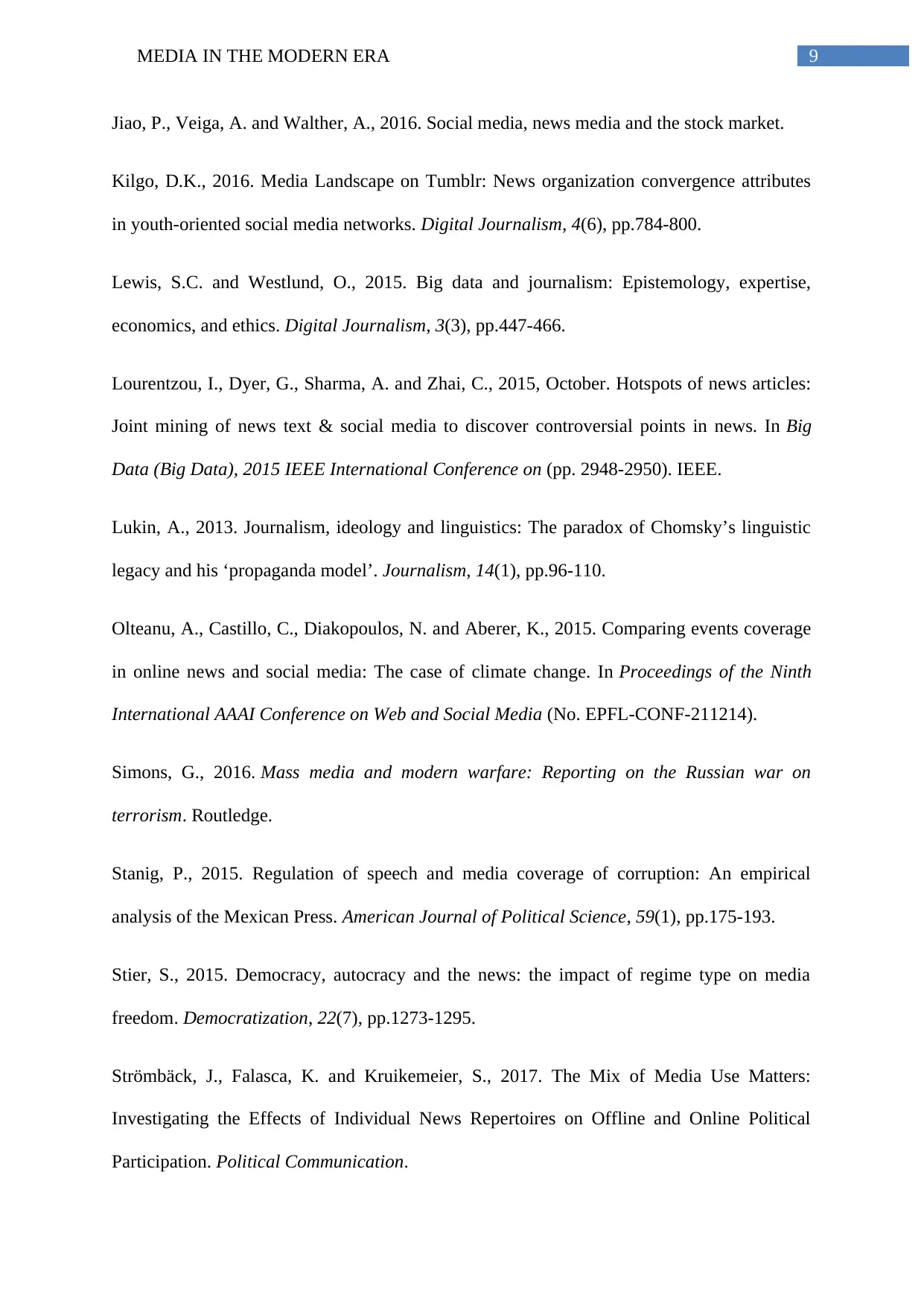
9MEDIA IN THE MODERN ERA
Jiao, P., Veiga, A. and Walther, A., 2016. Social media, news media and the stock market.
Kilgo, D.K., 2016. Media Landscape on Tumblr: News organization convergence attributes
in youth-oriented social media networks. Digital Journalism, 4(6), pp.784-800.
Lewis, S.C. and Westlund, O., 2015. Big data and journalism: Epistemology, expertise,
economics, and ethics. Digital Journalism, 3(3), pp.447-466.
Lourentzou, I., Dyer, G., Sharma, A. and Zhai, C., 2015, October. Hotspots of news articles:
Joint mining of news text & social media to discover controversial points in news. In Big
Data (Big Data), 2015 IEEE International Conference on (pp. 2948-2950). IEEE.
Lukin, A., 2013. Journalism, ideology and linguistics: The paradox of Chomsky’s linguistic
legacy and his ‘propaganda model’. Journalism, 14(1), pp.96-110.
Olteanu, A., Castillo, C., Diakopoulos, N. and Aberer, K., 2015. Comparing events coverage
in online news and social media: The case of climate change. In Proceedings of the Ninth
International AAAI Conference on Web and Social Media (No. EPFL-CONF-211214).
Simons, G., 2016. Mass media and modern warfare: Reporting on the Russian war on
terrorism. Routledge.
Stanig, P., 2015. Regulation of speech and media coverage of corruption: An empirical
analysis of the Mexican Press. American Journal of Political Science, 59(1), pp.175-193.
Stier, S., 2015. Democracy, autocracy and the news: the impact of regime type on media
freedom. Democratization, 22(7), pp.1273-1295.
Strömbäck, J., Falasca, K. and Kruikemeier, S., 2017. The Mix of Media Use Matters:
Investigating the Effects of Individual News Repertoires on Offline and Online Political
Participation. Political Communication.
Jiao, P., Veiga, A. and Walther, A., 2016. Social media, news media and the stock market.
Kilgo, D.K., 2016. Media Landscape on Tumblr: News organization convergence attributes
in youth-oriented social media networks. Digital Journalism, 4(6), pp.784-800.
Lewis, S.C. and Westlund, O., 2015. Big data and journalism: Epistemology, expertise,
economics, and ethics. Digital Journalism, 3(3), pp.447-466.
Lourentzou, I., Dyer, G., Sharma, A. and Zhai, C., 2015, October. Hotspots of news articles:
Joint mining of news text & social media to discover controversial points in news. In Big
Data (Big Data), 2015 IEEE International Conference on (pp. 2948-2950). IEEE.
Lukin, A., 2013. Journalism, ideology and linguistics: The paradox of Chomsky’s linguistic
legacy and his ‘propaganda model’. Journalism, 14(1), pp.96-110.
Olteanu, A., Castillo, C., Diakopoulos, N. and Aberer, K., 2015. Comparing events coverage
in online news and social media: The case of climate change. In Proceedings of the Ninth
International AAAI Conference on Web and Social Media (No. EPFL-CONF-211214).
Simons, G., 2016. Mass media and modern warfare: Reporting on the Russian war on
terrorism. Routledge.
Stanig, P., 2015. Regulation of speech and media coverage of corruption: An empirical
analysis of the Mexican Press. American Journal of Political Science, 59(1), pp.175-193.
Stier, S., 2015. Democracy, autocracy and the news: the impact of regime type on media
freedom. Democratization, 22(7), pp.1273-1295.
Strömbäck, J., Falasca, K. and Kruikemeier, S., 2017. The Mix of Media Use Matters:
Investigating the Effects of Individual News Repertoires on Offline and Online Political
Participation. Political Communication.
Paraphrase This Document
Need a fresh take? Get an instant paraphrase of this document with our AI Paraphraser

10MEDIA IN THE MODERN ERA
Sutko, D.M., 2014. Book Review: Brian Michael Goss Rebooting the Herman & Chomsky
Propaganda Model in the twenty-first century. Journalism, 15(5), pp.655-656.
Van Dalen, A., de Vreese, C. and Albæk, E., 2017. Economic news through the magnifying
glass: How the media cover economic boom and bust. Journalism Studies, 18(7), pp.890-909.
Sutko, D.M., 2014. Book Review: Brian Michael Goss Rebooting the Herman & Chomsky
Propaganda Model in the twenty-first century. Journalism, 15(5), pp.655-656.
Van Dalen, A., de Vreese, C. and Albæk, E., 2017. Economic news through the magnifying
glass: How the media cover economic boom and bust. Journalism Studies, 18(7), pp.890-909.
1 out of 11
Related Documents
Your All-in-One AI-Powered Toolkit for Academic Success.
+13062052269
info@desklib.com
Available 24*7 on WhatsApp / Email
![[object Object]](/_next/static/media/star-bottom.7253800d.svg)
Unlock your academic potential
Copyright © 2020–2025 A2Z Services. All Rights Reserved. Developed and managed by ZUCOL.





